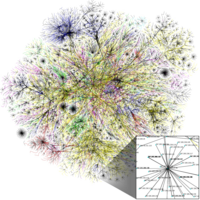
Photo from wikipedia
We present a statistical characterization of the morphological features emerging from the complex processes governing the growth of the road network, particularly in a mostly self-organized urban setting. Apart from… Click to show full abstract
We present a statistical characterization of the morphological features emerging from the complex processes governing the growth of the road network, particularly in a mostly self-organized urban setting. Apart from the usual fractal analysis, the roads are quantified by their lengths and straightnesses, while the segmented blocks are characterized by their areas, perimeters and circularities. When applied to the Metro Manila conurbation, one of the megacities in Asia with the fastest growing populations, we observe dense space-filling and nontrivial statistical distributions of roads and blocks that can be attributed to the geographical constraints of the metropolis. The emergence of the scale-free regimes is explained using a simple rule-based model patterned after the assumed dynamical interplay between the local and global factors involved in individual street formation. By viewing road network growth from a quantitative complex systems perspective, we can gain insights into the underlying rules operating at the local scales that give rise to the global spatial patterns.
Journal Title: International Journal of Modern Physics C
Year Published: 2018
Link to full text (if available)
Share on Social Media: Sign Up to like & get
recommendations!